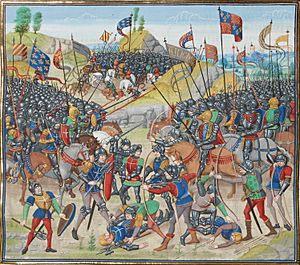Battle of Auray facts for kids
Quick facts for kids Battle of Auray |
|||||||
|---|---|---|---|---|---|---|---|
| Part of the War of the Breton Succession (Hundred Years' War) | |||||||
 |
|||||||
|
|||||||
| Belligerents | |||||||
| House of Montfort, Brittany Kingdom of England |
House of Blois, Brittany Kingdom of France |
||||||
| Commanders and leaders | |||||||
| John de Montfort John Chandos |
Charles of Blois † Bertrand du Guesclin (POW) |
||||||
| Strength | |||||||
| 6,000 men | 4,000 men | ||||||
| Casualties and losses | |||||||
| Unknown but comparatively lighter | 1,000+ | ||||||
The Battle of Auray was a very important fight that happened on September 29, 1364. It took place in a town called Auray in France. This battle was the final and most important clash of the Breton War of Succession. This war was itself a part of the much larger Hundred Years' War between England and France.
In this battle, two main groups fought. One side was a Breton army led by Duke John de Montfort. He was helped by English forces, whose commander was John Chandos. The other side was another Breton army, led by Montfort's rival, Charles of Blois. Charles was supported by French forces, led by a famous knight named Bertrand du Guesclin.
Contents
How the Battle Started
At the beginning of 1364, talks to make peace had failed. So, John de Montfort, with help from John Chandos, decided to attack Auray. This town had been controlled by the French and their Breton allies since 1342. Montfort's forces entered the town and started to surround the castle. Ships from Le Croisic, led by Nicolas Bouchart, blocked the castle from the sea.
The people inside the castle soon ran out of food. They agreed to give up if help didn't arrive by September 29. Just two days before this deadline, Charles of Blois arrived east of the Lanvaux abbey. Bertrand du Guesclin, who led the first group of French soldiers, was nearby in Brandivy.
On September 28, du Guesclin's army crossed the river and set up their position in front of the castle. To avoid being trapped between the castle and the French army, Montfort moved his troops out of Auray. He took a new position facing the enemy, on a hill on the other side of the river.
On September 29, attempts to make a peace deal failed again. Charles of Blois got ready to attack. His army crossed the river and lined up facing south. Some of his commanders thought this was a bad spot because it was on a wet, marshy plain. Montfort's army also moved, lining up facing north, on higher ground. Charles of Blois then ignored du Guesclin's advice and ordered his army to attack Montfort's forces.
The Armies Fighting
Charles of Blois's French-Breton Army
Charles of Blois's army had three main parts. On the left side was the Count of Auxerre. On the right was Du Guesclin. In the middle was Charles of Blois himself. They also had a group of reserve soldiers, but these were not used in the battle. Each of these main groups had about 1,000 men.
John of Montfort's English-Breton Army
John of Montfort's army also had different sections. On the right side was Olivier de Clisson. On the left was Robert Knolles. In the middle were John de Montfort and John Chandos. They also had a strong group of reserve soldiers, led by Hugh Calveley, who were ready to join the fight when needed.
The Battle Begins
The battle started with a quick fight between the French arbalesters (crossbowmen) and the English archers. After this, the main soldiers, called men-at-arms, charged directly at each other. They didn't try any fancy moves. It was a very bloody fight because everyone wanted this battle to end the long and cruel war. Both sides were told not to take prisoners, meaning the fight would be to the death.
Each part of the English-Breton army was attacked head-on, one after the other. But their reserve soldiers quickly stepped in to help and fix the situation. Then, the right side of the French-Breton army was attacked back and pushed away. Since their own reserve soldiers didn't help them, they were pushed back towards the center of their army. The left side of their army then also broke apart. The Count of Auxerre was captured. Soon, Charles of Blois's troops broke and ran away.
Charles of Blois was hit by a spear and then killed by an English soldier. This soldier was following the orders not to take prisoners. Du Guesclin, who had broken all his weapons, had to give up to the English commander Chandos. Du Guesclin was taken prisoner, but later, King Charles V of France paid a huge sum of 100,000 francs to free him.
What Happened After
This important victory finally ended the war of succession. One year later, in 1365, a peace agreement called the first Treaty of Guérande was signed. In this treaty, the king of France officially recognized John IV, who was the son of John of Montfort, as the new duke of Brittany. However, John IV then promised his loyalty to Charles V of France, instead of to his helper, Edward III of England. So, even though the English and Montfort won the battle, the King of France ended up gaining a diplomatic victory.


